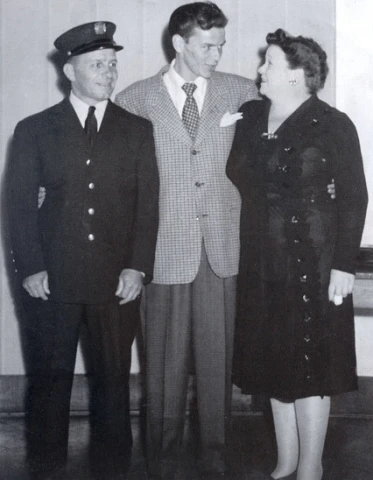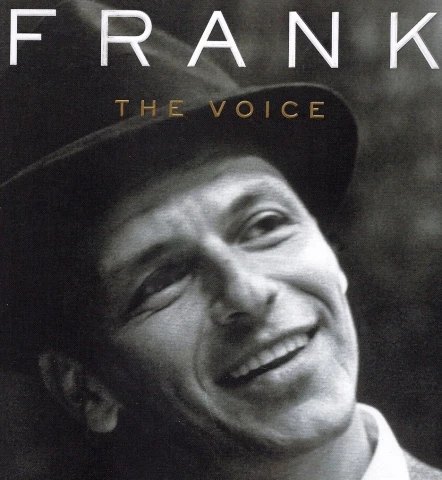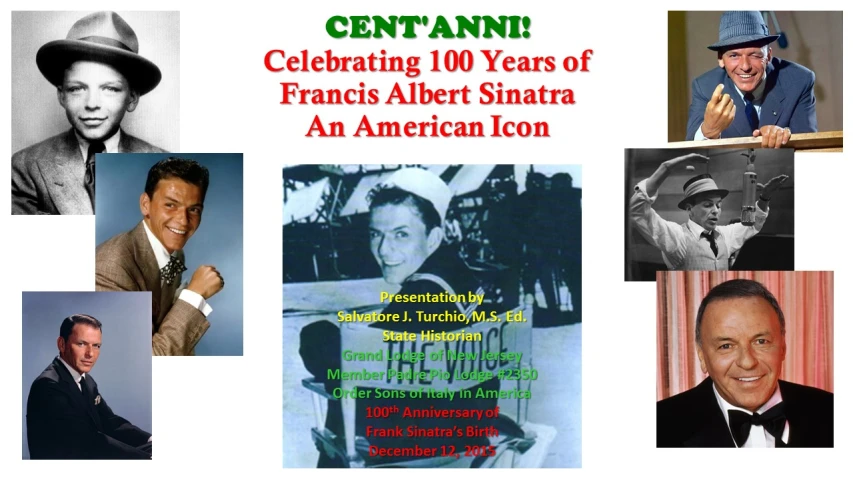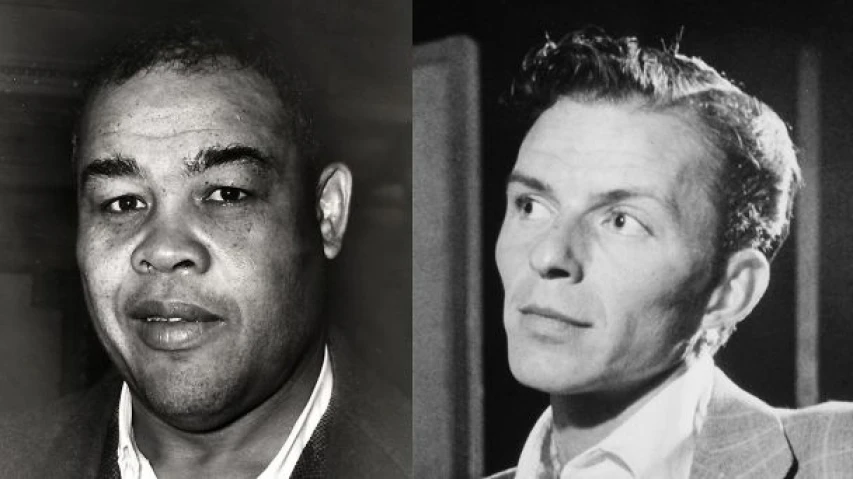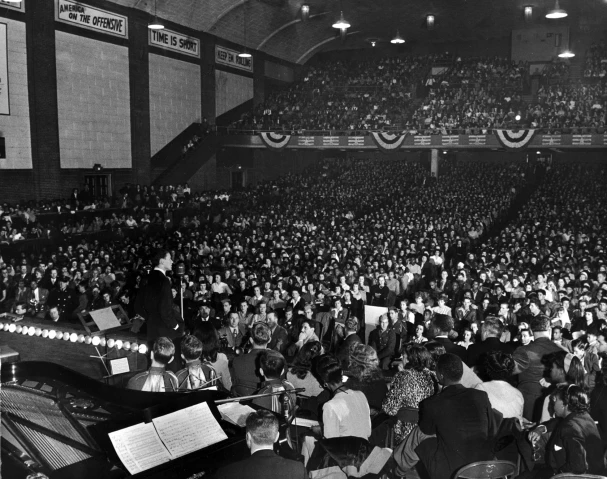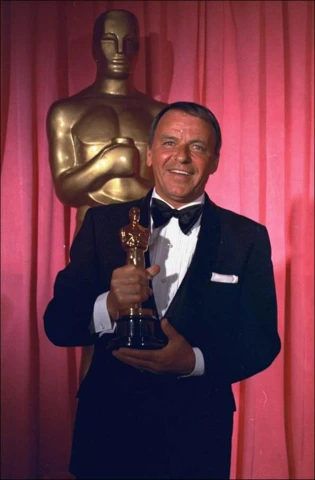It is not easy to say something new about a singer everybody called "The Voice": probably the most important and compete artist of the American XX century. Still, as this man was an Italian American, and on December 12 he would have turned 100, we feel important to dedicate one of our interviews to the legend of the great Frank Sinatra.
To do that, we have spoken with Salvatore "Sal" Turchio: he is the State Historian of the OSIA Grand Lodge of New Jersey, the State where Frank Sinatra was born. Sal comes from the province of Catania, the same Sinatra's father came from: a "native" son of Italy, who is extremely proud of his Sicilian and Italian heritage, and his naturalized American citizenship. We thank him because he helps us remembering the best, who will always live in the heart of all the Italians spread all over the world, and not only.
Sal, please tell us something about the Italian roots of Frank Sinatra
Francis Albert Sinatra was born on December 12, 1915 in Hoboken, New Jersey, the only child of Italian immigrants Saverio Antonino Martino Sinatra and Natalina Maria Vitoria Garaventa, who was known as Dolly.
"Martin" or "Marty" Sinatra, as he was known in America, was born on May 4, 1892 in Palagonia (provincia di Catania), Sicilia. Marty Sinatra became a boxer and fought under the name of "Marty O'Brien," because the Irish controlled just about everything in Hoboken and would not allow him to box under his Italian name. His boxing career left Marty with broken wrists. He attempted to find work in the shipping industry based in Hoboken, but was rejected due his asthmatic condition. Dolly helped him find work as a fireman, and he was eventually appointed to the Hoboken Fire Department in 1927, where he attained the rank of Captain. While still a captain in the fire department, Sinatra and his wife opened a tavern, called Marty O'Brien's. He died in 1969 of a heart attack.
Natalina was born on December 26, 1896, in Genova. She immigrated to the United States with her family when she was two months old. When she was a child, her pretty face earned her the nickname "Dolly." In February, 1913, Marty eloped with Dolly to Jersey City, New Jersey. Dolly's parents did not approve of Marty, as he was Sicilian. They refused to sanction the marriage. Dolly became involved in politics and worked as a midwife. She became very influential among the Italian community in Hoboken. She died in a plane crash in 1977.
The story of the artistic life of Frank Sinatra is self-explained by his nickname, "The Voice": he really was an icon of the show business for several years, wasn't he?
December 12, 2015 will mark the 100th anniversary of Frank Sinatra's birth. While the nation will not celebrate this date as a national holiday, we, as Italian Americans, should celebrate the life and legacy of America's greatest entertainer, whose career spanned 61 years over seven decades. At 66 years over 8 decades, the remarkable Tony Bennett (Anthony Dominick Benedetto) has surpassed Sinatra's longevity, but his outstanding career does not compare equally to that of Sinatra's.
American music history is populated with great vocalists who have made their mark on our collective music culture. However, there is one name that stands out more than the other recording and performing greats. He was an artist of such uncommon talent that he was known simply as "The Voice." Learning to sing mostly on his own, Sinatra was popular music's first true "teen idol," who made girls known as "bobbysoxers" scream and swoon. But Sinatra was more than a singer and performer. His career is a study of artistic excellence and the quest for perfection.
Are there things about his life, aside from his artistic side, that are not very well known but need to be told?
I want to focus on Sinatra's philanthropy, benevolence, social activism, and patriotism. Sinatra was not a perfect human being. None of us are. He was a tough kid from the streets of Hoboken, New Jersey, who grew up to be a top flight entertainer. He was tough with critics and people who disrespected or did not treat him well. He did not suffer fools gladly and he could be harsh, vulgar, and insulting. His infidelity is well known, but I am not here to dwell on that or his carousing lifestyle. He was who he was.
Nonetheless, he remained a loving son, father, and grandfather. He treated his first wife, the former Nancy Barbato - still alive at 97 years young - like she was always his first love and always took care of her needs, no matter what they might be. He was a fiercely loyal friend who would do anything for you. But, once you insulted him or disrespected him or his family, you were gone from his life. I must candidly admit that this is a trait that Frank probably inherited from his Sicilian-born father, Marty. Or, more so from his fiercely protective, politically savvy and active, and well-educated mother, Dolly.
Thanks to the research I did in producing my presentation, "CENT'ANNI! Celebrating 100 Years of Francis Albert Sinatra – An American Icon," I discovered more information than I ever knew or imagined about the non-performer side of Sinatra. I was aware of his philanthropy to a certain extent, but the list and enormity of his contributions remains unknown to most people. He raised millions upon millions of dollars through foundations he created, benefit concerts and appearances, and prompting his friends and business associates to do the same. As with most of his philanthropic endeavors, Sinatra never wanted public attention drawn to them and certainly did not tout them through public relations staff, flacks, or the media types that hover over today's celebrities.
The biggest difference between Sinatra and today's "celebrity philanthropists" is that he actually believed in what he did and took it personally. Most importantly, his generosity came from his heart, and not the quest for publicity and ego enrichment that drives most, if not all, of today's "celebrity philanthropists."
To give you a better sense of the breadth of Sinatra's philanthropy, here is a partial list of the organizations, charities, and country that benefitted from his largesse: American Italian Anti-Defamation League; St. Jude Children's Research Hospital; Cabrini Medical Center; Marian Medical Mission; Memorial Sloan Kettering Cancer Center; St. John's Hospital; Cedars Sinai Hospital; Duke University's Children's Hospital; Atlantic City Medical Center; Eisenhower Medical Center; Reiss-Davis Clinic; International Red Cross; American Red Cross; March of Dimes; American and International Heart Associations; Multiple Sclerosis Society; Muscular Dystrophy Association; United Cerebral Palsy; Easter Seals; City of Hope Cancer Center; Myasthenia Gravis Foundation; Jules Styne Eye Institute; Retinitis Pigmentosa Foundation; Prevention of Blindness Society of Metropolitan Washington; Boys Town; Child Abuse Foundation; National Society For the Prevention of Cruelty To Children; Barbara Sinatra Center for Abused Children (founded by Frank Sinatra, it is located at the internationally acclaimed Eisenhower Medical Center); Villa Scalabrini Retirement Center; Foster Grandparent's Plan; Dismas House St. Martin's Hospitality Center; The State of Israel; Hebrew University; Jewish Welfare Fund; B'nai B'rith International; NAACP; SCLC; Neighbors of Watts; Variety Clubs International; The Society of Singers; NosOstros; Musician's Unions; Loyola Marymount University; USC; UCLA; ACLU.
Sinatra also helped untold numbers of individuals who needed financial or medical assistance. Actors George Raft (he owed the IRS hundreds of thousands $$) and Lee. J. Cobb (out of work for years because he "named names" to House Un-American Activities Committee) are just two examples of Sinatra's financial generosity. He is reported to have sent them signed blank checks with instructions to fill in the amount they needed. Countless others benefitted from anonymous donations, often through intermediaries. Again, there was no fanfare, press coverage, or desire for public adulation.
Boxing immortal Joe Louis' story was an especially tragic one. An American hero, who defeated the German heavyweight champion Max Schmelling in one of the greatest fights ever held, Louis was treated shabbily by the US government, which used him for patriotic "propaganda" films, events, and US bond campaigns during WWII. After his first retirement in 1949, the IRS was still completing its investigation of Louis' prior tax returns, which had always been handled by his manager's personal accountant. In May 1950, the IRS announced that, with interest and penalties, he owed the government more than $500,000. Louis had no choice but to return to the ring and turn over his winnings to the IRS until his debt was satisfied. Louis, now past his prime, continued fighting and suffered savage beatings in the ring. His purses were mismanaged and siphoned by his managers and handlers.
Sinatra and Louis were very close friends since the 1940s. When Louis suffered cardiovascular problems, some of which ultimately damaged his speech and his ability to walk, Sinatra called Louis' wife Martha and told her not to worry about the cost of his medical care. He insisted that the Louis receive the best medical care and had Louis flown in his personal jet to Houston, where he was operated on by the renowned cardiac surgeon Michael DeBakey. Sinatra also arranged for Louis to get various jobs and, as a final act of respect, he paid for Louis' funeral costs.
He was also a very active social activist, right?
When it came to social activism, Sinatra was ahead of his time. He was an (Eleanor) Roosevelt Democrat who believed in helping the downtrodden and underrepresented. Sinatra's parental upbringing in Hoboken, especially by his politically active his mother, did much to shape his "common man" persona. As a kid, he was often bullied and beaten by Irish American kids who did not like the "wops" and "dagos" who "infiltrated" their town. Thus was shaped his lifelong desire to always help those "bullied" or "beaten" for ethnic, racist, religious, or economic reasons.
Here are some of the most notable examples of Sinatra's social activism:
1) "The House I Live In" – The most famous and well-known of Sinatra's public/political statements about discrimination and prejudice, in this case religious. This 1945 short documentary earned Sinatra a Special Academy Award Oscar, which today would be categorized under the "Best Documentary - Short" category. Sinatra was ahead of his time. In the 1940s, no other singer, actor, or other celebrity would dare take on the subject of anti-Semitism. Not even the heads of Hollywood's studios, all of whom were Jewish, would even broach the subject for fear of alienating the predominantly WASP viewing audience. If you have never viewed this documentary, you can download it on the internet. When you do, listen to the words Sinatra directs at the boys, which are far more important than his signature song, "The House I Live In."
Note: After the release of "The House I live In," right-wing papers started calling Sinatra "a pawn of fellow travelers," which was a term used to describe communists. " In the eight years following "The House I Live In," Sinatra was named twelve times in HUAC hearings. The New York Times Index has only one entry for Sinatra in 1949: "Sinatra, Frank: See US-Espionage." The Hearst gossip columnists went after him; in 1947 he punched one of the most abusive, Lee Mortimer, at Ciro's in Hollywood. The Hearst papers ran whole pages on the punch, and on the crooner's political problems; one headline read "Sinatra Faces Probe on Red Ties." Sinatra said Mortimer had called him a "dago." Mortimer had been saying in his column that HUAC regarded Sinatra as "one of Hollywood's leading travelers on the road of Red fascism." He pledged to "continue to fight the promotion of class struggle or foreign isms posing as entertainment"–like "The House I Live In." (Excerpted from "Frank Sinatra: His Way - The bell ring-a-ding-dings for Ol' Blue Eyes," by Jon Wiener, June 15, 2009, The Nation.)
2) Student Strike in Gary, Indiana - Also in 1945, Sinatra was invited to Gary, Indiana where white students from the Froebel School (Gary's only integrated school at the time) were boycotting classes. The boycott began on September 18th as an attempt to have Froebel's black students removed. The school's Principal, Richard A. Nuzum, who had been fighting against the oppression of black students at Froebel was also scrutinized, as the boycotting students called for his dismissal. When an investigation of Nuzum was opened on October 1st, the boycott ended–temporarily. After three weeks, however, Nuzum was found to be a fit principal, and the outraged white students resumed their walkout. When the school's administrators had no luck in convincing students to return to classes, they invited both Sinatra and heavyweight champion Joe Louis to visit the school. While Louis was unable to break previous commitments, Sinatra cancelled a $10,000 gig to speak at Froebel. To a packed auditorium, Sinatra sang the rousing song from his short film, also titled "The House I Live In," which includes the line, "All races and religions – that's America to me." He also gave a speech, calling the boycott "the most shameful incident in the history of American education." The strike ended just 11 days later. He may have given up a $10,000 engagement, but Sinatra made more than a statement by appearing in Gary. This little-known event made an impact on history, something no amount of money could have done. (Excerpted from "Events that changed history – how fighting for racial integration cost Frank Sinatra a $10k gig, but he did it anyway," by Belle Beth Cooper, January 9, 2013 – Attendly.com)
He once said: "We've got a hell of a long way to go in this racial situation. As long as most white men think of a Negro first and a man second, we're in trouble. I don't know why we can't grow up."
How about a specific anecdote regarding your relationship with Sinatra ...
My wife and I saw Sinatra in concert four times. One notable performance was in 1984 at New York City's Carnegie Hall, an absolutely magnificent venue whose acoustics are unmatched anywhere in the USA. Sinatra was accompanied by a full orchestra, all of whom were dressed in tuxedos. Sinatra wore a tuxedo with tails. In between songs, he would share anecdotes with the audience. One of them was his apparent dislike for his home state, New Jersey. What he said flabbergasted my wife and me, and most of the audience, I am sure: "I hope New Jersey detaches itself from the rest of the country and floats away into the Atlantic Ocean." We later found out that earlier that year Sinatra vowed never to visit the state of New Jersey again after a member of the Casino Control Commission denounced him as an "obnoxious bully" for forcing a blackjack dealer to violate state law. Sinatra never suffered fools gladly, so he reacted in his own candid fashion.
Fortunately, Stevens Institute of Technology in his home town of Hoboken, New Jersey, decided to award Sinatra an honorary degree at its May 1985 Commencement Ceremony. Stevens' president, Dr. Kenneth C. Rogers, met Sinatra in July 1984 when the singer accompanied President Ronald Reagan to Hoboken on a campaign trip. Dr.Rogers sent Mr. Sinatra a photograph of the singer taken on the institute's campus. The correspondence opened the door for an invitation the college had been considering for more than 10 years. Sinatra lamented the fact the he never finished high school and had wanted to attend Stevens if he had. Thus, Sinatra accepted Dr. Rogers' invitation and gladly came returned home to Hoboken. His disparaging words at Carnegie Hall were forgotten, and Hoboken welcomed back its favorite son!
Why was (and still is) he so important for the Italian Americans?
Frank Sinatra will always be important to Italian Americans because he was one of them. Although Sinatra was always billed as an "American" singer, he was fiercely proud of his Italian heritage. Unlike other Italian American performers and celebrities, Sinatra never changed his name. Dino Crocetti became Dean Martin. Anthony DiBenedetto became Tony Bennett. The list goes on and on, but Sinatra kept his "vowels" at a time in American history (1915 – 1935) when Italians were still considered an immigrant class and were frequently disparaged by the more assimilated ethnic groups. The following words from the famous Italian American writer and author, Gay Talese nicely sum up how the generations who grew up listening to the young Sinatra in person, or on the radio, felt: "In the World War II years, the voice of Frank Sinatra coming through the 'Lucky Strikes Hit Parade' on the radio, which I used to listen to every Saturday night. The fact that he had an Italian name, Sinatra was an Italian name, and he was the only guy that made me feel good about being Italian. Sinatra spoke out. He sang out. He was speaking English beautifully. The diction, the Sinatra intonation of a lyrical ballad was precisely clipped. You could understand the words. And when you came from homes where English wasn't spoken well, we of my generation - the Italian American offspring of the immigrant class - did not have sense of English being spoken perfectly. And Sinatra was speaking and singing English perfectly."
These sentiments by the young Talese signified the adulation and respect Italians and Italian Americans had, and still have, for Sinatra.
What's his legacy?
The legacy of Francis Albert Sinatra is very clear: he is the best entertainer this country has ever produced. People might argue that others were better, but it would be a futile argument. For 61 years over seven decades, Sinatra did it all--singer, actor, concert performer, radio and television star, and producer. Most importantly, his philanthropy, benevolence, social activism, and patriotism remains unsurpassed by any American celebrity past and present. Francis Albert Sinatra, son of Italy, was benevolent, generous, loyal, and always true to himself.


